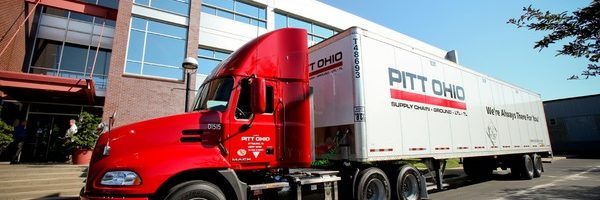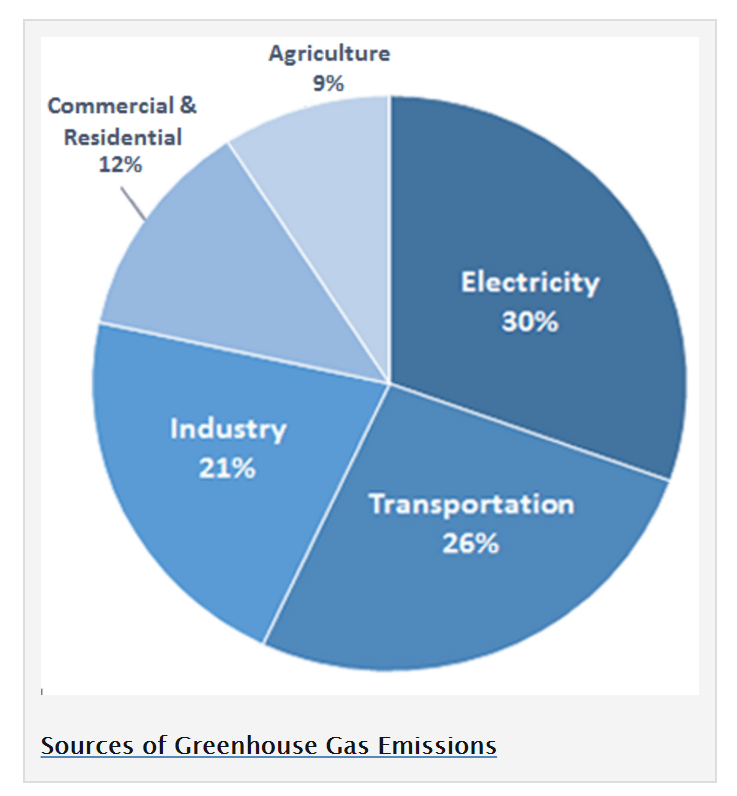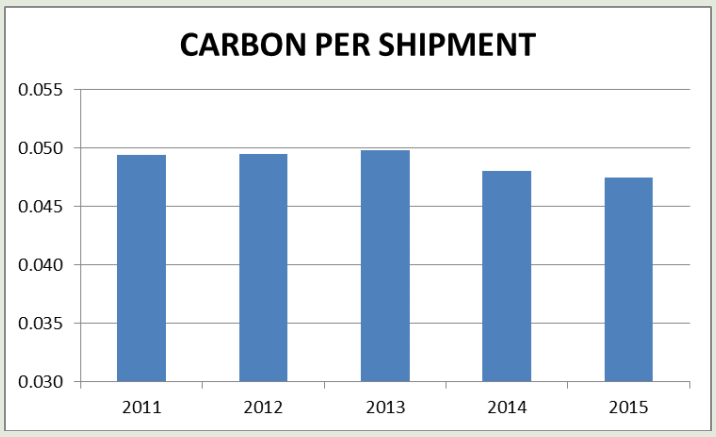Combating Climate Change at PITT OHIO Express

PITT OHIO Express is utilizing green initiatives in order to increase new business and drive down expenses.
Industry Overview
Climate change has become a hot-button issue across industries, but perhaps none has been portrayed as negatively as the transportation industry. This is partly due to the explosive growth anticipated in the sector, where experts estimate growth at 100% in the Southern USA and 79% in the Northeast between 2000 and 2020[1]. In addition to said growth, transportation of people and goods is estimated to be responsible for 26% of all greenhouse gas emissions in the USA[2] (Figure 1). These two factors combine to result in an industry facing increased social and regulatory pressures to significantly alter their operating models.

Impact on PITT OHIO Express
PITT OHIO Express, a privately held transportation carrier, provides supply chain solutions throughout the Mid-Atlantic and Midwest United States. With annual revenues estimated at $550,300,000 for 2015 and growing at an average of 15.8% per year over the last four years[3], PITT OHIO is in a prime position to capitalize on previous success. Though, a question remains: Will PITT OHIO continue to grow while providing enough value in sustainability to win customers in a trucking industry that generates significantly more emissions than alternate forms of freight transportation[4].
Company Response
At a corporate level, PITT OHIO has recognized the need to be an industry leader in adopting innovative sustainability technology. To that effect, they’ve not only become an EPA SmartWay Partner[5],[6], but also a 2016 SmartWay Excellence Award Winner[7]. To achieve these results, PITT OHIO has pulled a variety of levers, including fleet composition changes and reducing effective carbon output[8].
- Fleet composition changes: Heavy duty trucks comprise about 10% of all nitrogen oxide emissions (harmful air chemical) in the USA[9]. To combat their own pollution, PITT OHIO has actively been retiring old diesel trucks and replacing them with compressed natural gas (CNG) engine tractors. Over the past 2 years, PITT OHIO has added 32 CNG trucks, representing about 3% of their fleet and growing[10]. This investment in CNG tractors has strengthened the company in a variety of ways. Every CNG tractor produces 13% fewer greenhouse gas emissions versus a diesel engine[11]. As such, each replaced truck is helping reduce the company’s overall carbon footprint. In addition to that, this transition is actually earning PITT OHIO new business amongst a newer, more carbon-responsible class of customers.
- Carbon Output Reductions: PITT OHIO has also reduced emissions of harmful greenhouse gasses via an in-house tool developed, the Carbon Calculator. Using said calculator, the company is able to determine the impact of both their actions and their customers on the environment. This tool has been used to shape everything from truck allocation to route planning in order to optimize carbon reduction. As a result, PITT OHIO has reduced the carbon emissions per shipment by 1.2% over the last year (Figure 2), a net carbon emission savings of 73 metric tons, equivalent to more than 15 passenger cars driven for 1 year[12]. The availability to harness and provide this information has led to PITT OHIO earning numerous new accounts.

Trending of PITT OHIO’s reduction in carbon ton emissions per shipment. PITT OHIO Express, “2015 Sustainability Report”, Accessed November 2016.
Conclusion
PITT OHIO is well positioned to withstand external pressures from both regulatory bodies and competitors. Their unique positioning as a ‘green’ alternative in the traditionally slow-to-change transportation industry has already led to economic benefits via increased sales and reduced expenses. As the company continues to scale CNG tractors and initiatives such as harnessing solar to power their shipping terminals, I expect them to remain a foremost authority on how a transportation company can thrive while combating climate change.
Word Count (excluding citations): 750
[1] OECD (2001): European Transport Policy for 2010: Time to Decide. OECD Publication, Paris, France, quoted in The International Journal of Life Cycle Assessment, 2006, Volume 11, Number 4, Page 229, Arpad Horvath, http://download.springer.com.ezp-prod1.hul.harvard.edu/static/pdf/71/art%253A10.1065%252Flca2006.02.244.pdf?originUrl=http%3A%2F%2Flink.springer.com%2Farticle%2F10.1065%2Flca2006.02.244&token2=exp=1478031497~acl=%2Fstatic%2Fpdf%2F71%2Fart%25253A10.1065%25252Flca2006.02.244.pdf%3ForiginUrl%3Dhttp%253A%252F%252Flink.springer.com%252Farticle%252F10.1065%252Flca2006.02.244*~hmac=55955c3d16923adbacdd1be141ea69d4627c7af1630ed8a757cce6ba7d968332, Accessed November 2016.
[2] US Environmental Protection Agency, “U.S. Greenhouse Gas Inventory Report: 1990-2014”, https://www.epa.gov/ghgemissions/us-greenhouse-gas-inventory-report-1990-2014, Accessed November 2016.
[3] Transportation Topics News, “Top 100” http://www.ttnews.com/top100/companies/profile.aspx?co=pittohio Accessed November 2016.
[4] OECD Publication, Paris, France, quoted in The International Journal of Life Cycle Assessment.
[5] US Environmental Protection Agency, “SmartWay Partner List”, https://www.epa.gov/smartway/smartway-partner-list, Accessed November 2016.
[6] Note: EPA’s SmartWay program helps companies advance supply chain sustainability by measuring, benchmarking, and freight transportation efficiency.
[7] US Environmental Protection Agency, “SmartWay Excellence Awards”, https://www.epa.gov/smartway/smartway-excellence-awardees, Accessed November 2016.
[8] PITT OHIO Express, “2015 Sustainability Report”, http://works.pittohio.com/mypittohio/sustainability/2015_Sustainability_Report.pdf?utm_source=SustainabilityReport2015&utm_medium=Website&utm_term=Sustainability&utm_campaign=SustainabilityReport2015, Accessed November 2016.
[9] Waste 360, “TRUCKS: Fueling the Diesel vs. Natural Gas Debate”, http://www.waste360.com/mag/waste_trucks_fueling_diesel, Accessed November 2016.
[10] Author’s interview with Justine Russo, November 1, 2016.
[11] NGVAmerica, “Environmental Benefits”, http://www.ngvamerica.org/natural-gas/environmental-benefits/, Accessed November 2016.
[12] PITT OHIO Express, “2015 Sustainability Report”.



It seems like PITT OHIO is modeling the way not only for its competitors in the trucking space but also for its customers who are seeking a more environmentally responsible transportation option. I am excited by the Carbon Calculator tool which enables information symmetry for both PITT and their customers. This tools seems like an effective way to influence customer behavior (equipping them to think more strategically about frequency of shipments and geographies) while also allowing PITT to be more efficient as well… Win-win! Tools that drive awareness of carbon consumption and allow the consumer and the business to solve problems together are an exciting frontier in our march towards sustainability. As businesses look upstream at how to harvest more sustainable practices in their supply chains, I recommend that a tool like this is key to sharing information and unlocking mutually beneficial solutions.
Amazing read Kyle! Our trucking and logistics infrastructure is a huge contributor to climate change and it’s exciting to hear what PITT OHIO is doing to mitigate their impact. However, I question whether CNG is part of that correct answer. While CNG does contribute fewer greenhouse gasses to the surrounding environment[1], it’s questionable whether the system from the capture of CNG to consumption is better. During mining, capture, and transportation of CNG, there is a large amount of gas that escapes . Unfortunately methane (CH4), the predominant ingredient in natural gas is also one of the worst contributors to the greenhouse effect. So while it may be with the best intentions, is PITT OHIO really helping by changing their fleet to this new fuel?
[1] Goyal, P., 2003. Present scenario of air quality in Delhi: a case study of CNG implementation. Atmospheric Environment, 37, 6.